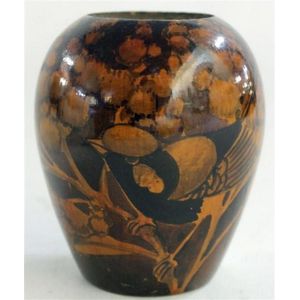"Mandarin Tree" Carlton Ware Vase
You must be a subscriber, and be logged in to view price and dealer details.
Subscribe Now to view actual auction price for this item
When you subscribe, you have the option of setting the currency in which to display prices to $Au, $US, $NZ or Stg.
- Gilding - Gilding is a method of ornamentation whereby a thin sheet of gold metal is applied to items made of wood, leather, ceramics, glass and silver for decorative purposes.
For furniture including mirrors, the sheet of gold is usually applied over a coating of gesso. Gesso is a mixture of plaster of Paris and gypsum mixed with water and then applied to the carved wooden frames of mirrors and picture frames as a base for applying the gold leaf. After numerous coats of gesso have been applied, allowed to dry and then sanded a coat of "bole", a usually red coloured mixture of clay and glue is brushed on and allowed to dry, after which the gold leaf is applied. Over time parts of the gilding will rub off so the base colour can be seen. In water gilding, this was generally a blue colour, while in oil gilding, the under layer was often yellow. In Victorian times, gilders frequently used red as a pigment beneath the gold leaf.
Metal was often gilded by a process known as fire gilding. Gold mixed with mercury was applied and heated, causing the mercury to evaporate, the long-term effect of which was to kill or disable the craftsman or woman from mercury poisoning. The pursuit of beauty has claimed many victims, not the least of which were the artists who made those pieces so highly sought after today. - Circa - A Latin term meaning 'about', often used in the antique trade to give an approximate date for the piece, usually considered to be five years on either side of the circa year. Thus, circa 1900 means the piece was made about 1900, probably between 1895 and 1905. The expression is sometimes abbreviated to c.1900.
This item has been included into following indexes:
- Carlton Ware (England), item types - vases and ewers 286
- Carlton Ware (England), patterns
Visually similar items

A Hiel Co. Ware pokerwork timber vase, with wattle and willy wagtail bird design. Height 9 cm

A Carlton Ware 'Persian' vase, 1927-1938, introduced 1924, shape 443, pattern attributed to Enoch Boulton, with a figure seated within a temple accompanied by musicians and other attendants in an exotic garden setting, with flowers, birds, palms in enamel

Gouda Royal Goedewaagen vase of round form, having a glosed glaze with floral motifs, duck egg blue interior & marked to the base 'Kers Royal Goedewaagen Gouda Made in Holland'. Condition good, minor wear to the base. Height 15 cm

A Carlton Ware 'Mandarin's Chatting' baluster vase, circa 1932, pattern with design attributed to Violet Elmer, shape 443 until 1938. Depicting two figures chatting beneath a twisted tendril embellished tree upon a gloss black ground between rouge friezes,
